Texas Counties
Texas is divided into two hundred and fifty-four counties, more than any other state. Texas was originally divided into municipalities, a unit of local government under Spanish and Mexican rule. When the Republic of Texas gained its independence in 1836, there were 23 municipalities, which became the original Texas counties. Many of these would later be divided into new counties. The most recent county to be created was Kenedy County in 1921. The most recent county to be organized was Loving County in 1931Marion County, Texas
Marion County Education, Geography, and History

Marion County is a county located in the state of Texas. Based on the 2010 census, its population was 10,546. Its county seat is Jefferson. Marion County is in East Texas and is named for Francis Marion, the Revolutionary War general from South Carolina who was nicknamed the "Swamp Fox"
Etymology - Origin of Marion County Name
Francis Marion, the American Revolutionary War general whose nickname was the "Swamp Fox"
Demographics:
County QuickFacts: CensusBureau Quick Facts
Marion County History
The farming Caddoan Mississippian culture dates as far back as 200 BCE in the area. The Hernando de Soto expedition
of 1541 resulted in violent encounters. Spanish and French missionaries brought a smallpox, measles malaria and influenza epidemics against
which the Caddo had no immunity. Eventually, the Caddo were forced to reservations. Shashidahnee (Timber Hill) is the last known permanent
Marion County settlement of the Caddo people. The 19th Century saw Shawnee, Delaware, and Kickapoo in the area.
The legislature formed Marion County from Cass County in 1860 and named for Revolutionary War Swamp Fox Francis Marion . Jefferson, named
after Thomas Jefferson became the county seat. Marion County is in
East Texas and is named for Francis Marion, the Revolutionary War general who was nicknamed the "Swamp Fox".
Handbook of Texas Online
Marion County (D-22) is in northeastern Texas; its eastern boundary forms a portion of the Louisiana-Texas
border. Jefferson, the county's largest town and its county seat, is seventeen miles north of Marshall, in Harrison
County, and forty-six miles west of Shreveport, Louisiana. The county's center is at 32047' north latitude and
94020' west longitude. Marion County covers 380 square miles of the dense timberlands of East Texas.
The land surface is a gently rolling, rich, sandy loam, underlain by a clay foundation and cloaked by pine, cypress,
and oak forests. The elevation is 200 to 500 feet above sea level. The county is drained by the Red River basin via
the watershed areas of Caddo Lake, Lake o' the Pines, and Big Cypress, Little Cypress, and Black Cypress bayous. The
region's mineral deposits include oil, natural gas, clay, and lignite coal. Temperatures range from an average low
of 320 F to an average high of 540 F in January and from 710 to 930 F in July. The growing season is 236 days in
length, and the yearly rainfall is forty-four to forty-five inches. Marion County was demarked from the southern
portion of Cass County by an act of the state legislature on February 8, 1860. Territorial additions in 1863 and
1874 extended its southern boundary to include both banks of Big Cypress Bayou. The county was named for American
Revolutionary War hero Francis Marion, the "Swamp Fox." Due to a large natural log-jam and collection of snags on
the Red River, known as the Red River Raft, which formed a series of navigable lakes and bayous in the river valleys
of Marion County, Jefferson, founded in the early 1840s, rapidly developed a booming river trade with New Orleans.
Jefferson quickly became the favored inland Texas port for the deposit and transport of North Texas agricultural
produce. Thus, Marion County became the commercial conduit for frontier Texas and did not relinquish this position
until the establishment of transcontinental rail links that bypassed its wharves in the mid-1870s. Another important
attribute of Marion County's early character was the geographical and cultural origins of its residents. Ninety
percent of them migrated from the Deep South and the border states of Tennessee, Arkansas, and Missouri, bringing
with them the slave economy of their former environment. In 1860 the slave population of Marion County constituted
51 percent of the total population. Slaveholders, though small in number (213), held 60 percent of the county's
wealth and dominated its political institutions. Marion County sent two of its prominent citizens, James H. Rogers
and William S. Todd, to the Secession Convention,
and the county's voters unanimously approved the Ordinance of Secession in 1861. More at
Mark Howard Atkins, "MARION COUNTY," Handbook of Texas Online (http://www.tshaonline.org/handbook/online/articles/hcm02),
accessed January 24, 2016. Uploaded on June 15, 2010. Modified on March 12, 2014. Published by the Texas State Historical Association.
Geography: Land and Water
As reported by the Census Bureau, the county has a total area of 420 square miles (1,089 km2), of which, 381
square miles (987 km2) of it is land and 39 square miles (102 km2) of it (9.31%) is water.
Neighboring Counties
Bordering counties are as follows:
- Cass County (north)
- Caddo Parish, Louisiana (east)
- Harrison County (south)
- Upshur County (west)
- Morris County (northwest)
Education







